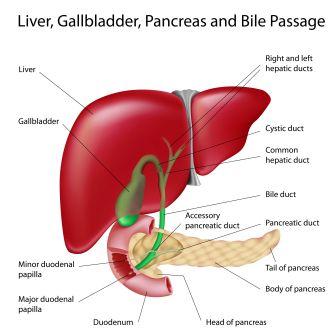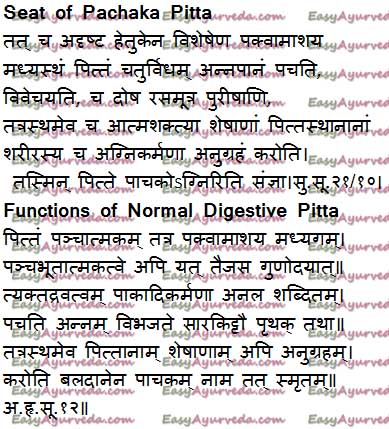Pachaka Pitta Location, Functions, Imbalance, Treatment
By Dr Raghuram Y.S. MD (Ay) & Dr Manasa, B.A.M.S
Pachaka means ‘that which digests’. Pitta which digests the food is called Pachaka Pitta.
Table of Contents
Introduction
Since pitta is said to be a representative of fire in body, the suffix agni is also given to all subtypes of pitta. In this context, pachaka pitta is also called as pachakagni (pachaka + agni), the ‘food digesting fire’. I would call it ‘digestive pitta’.
Pachaka Pitta is one of the five subtypes of pitta.
Read – Understand Pitta Dosha By Its Functions
Location
Seat of Pachaka Pitta
Pachaka pitta is seated in small intestine, in between stomach and large intestine.
The seat where it is located is called grahani.
Read – Charaka Grahani Dosha Chikitsa 15th Chapter

Grahani means duodenum. Another slight variation of this term is Gruhini – housewife.
Duodenum is the first part of small intestine where digestion of food takes place.
Housewife cooks the food, such that it is compatible and conducive for all the family members. Similarly, duodenum also digests the food properly such that it becomes compatible and conducive for entire body and its components.
Read – IBS: Ayurvedic Treatment, Home Remedies, Lifestyle Tips
I will put it the other way. Let us consider a kitchen. How much ever the kitchen may be equipped, delicious food is prepared only by the housewife.
If the woman who handles kitchen is not wise or if tired, the prepared dish would be equally pathetic and non-conducive. Therefore the woman who prepares food should be physically and mentally sane enough to prepare good stuff for her family. Similarly how much ever the woman is fit and good, if kitchen is not equipped as per her requirements, the prepared dish would still be compromised.
Read – Ayurvedic Pitta Diet – food suitable for Pitta body type
Now we shall flip places. Consider duodenum or intestine as the kitchen and digestive pitta, the functional component of the kitchen i.e housewife.
If there is a good compatibility between the intestine and the functioning of digestive pitta, all four forms of food which are consumed would be digested in a good way. Nutritional juices (rasa) formed out of such good digestion would be wholesome, nutritional and conducive to all tissues, and of course for the maintenance of health in a comprehensive way.
Small representatives of digestive pitta or jathara agni are present everywhere in the body in the form of tissue fire (dhatu agni) and elemental fire (bhuta agni).
Read – How To Balance Pitta Dosha? Line Of Treatment
Sanskrit sloka

Functions
Functions of Normal Pachaka Pitta
Pitta is said to be pancha bhutatmaka i.e. made up of all five elements of nature but predominant in fire element. Subtype of pitta located in between pakwashaya (colon) and amashaya (stomach and small intestine) is also made up of five elements of nature and is predominant in fire component.
Being fiery in nature, this pitta is devoid of liquid component (the water component of this pitta is less in comparison to the water component of other pitta sub-types).
Since it renders functions like digestion and segregation of food, this dry form of pitta is called anala (synonym of fire) and is named as pachaka pitta i.e. pitta which digests food.
Being located in small intestine (duodenum to be precise), pachaka pitta supports functions of other pitta subtypes located in other places of body by the virtue of its inherent power.
Read – Effect of Stress, Anxiety on Stomach And Intestines: Remedies
Digestion
Digests food and breaks it into smaller components –
The fire is said to be present in the body in the form of pitta.
Generally this statement explains pachaka pitta. Normal pachaka pitta properly digests four types of food consumed by us, those are which we swallow, munch (chew), drink and lick.
It not only digests the food but also converts complex food substances into finer substances which can be absorbed and assimilated. When these simpler substances of food go into circulation they reach the tissues.
The tissue fire and elemental fire further act on these food substances and convert them into a form which is assimilated by the tissues. This further helps in formation of tissues and other components of the body.
Read – Understanding Digestion Process From An Ayurveda View
In digestion of food, the pachaka pitta is helped by samana vata and kledaka kapha.
Following the primary digestion of food in stomach and intestines by pachaka pitta, the tissue and elemental fire in tissues would further digest and process the nutritional juices reaching them.
Thus, digestion of food in intestines, breakdown of food in tissues and conversion of this food by tissues into heat and energy needed for daily body activities depend on the integrated functioning of pachaka pitta i.e. digestive fire in form of gut pitta, tissue fires and elemental fires.
Read – Peptic Ulcers: Causes, Ayurvedic Treatment, Herbs, Home Remedies
Bifurcation and differentiation of food into useful and waste products –
After digesting all forms of consumed foods, digestive pitta differentiates and bifurcates food into useful products and waste products.
The useful part separated from digested food is called rasa or nutritive juice. This is put into circulation and nourishes all tissues.
The waste products are produced in form of doshas, urine and feces. While the doshas take care of body and participate in carrying on normal functioning of different tissues and organs, the feces and urine are excreted out of body.
Read – Rasa Dhatu: Definition, Formation, Circulation, Imbalance Diseases, Treatment
Doshas when vitiated will produce diseases. If this happens, they should be eliminated from body by administering suitable treatments.
Nourishing other pittas
Nourishes and strengthens other pittas –
Digestive pitta being located in its own place, nourishes, supports and strengthens other 4 subtypes of pitta located in various places of body. At the same time this pitta also supports the entire body and body functions.
Thus, digestive pitta is considered as most important type of pitta since it controls the functions of other types of pittas in body too.
If there is an increase in digestive pitta, the other pittas and fires in body too will get increased. Thus there is hyperactivity everywhere. Since it is the fire which increases there will be burn outs and inflammation taking place all through the body.
Read – Pitta Increase Symptoms – Pitta Vriddhi Lakshana
Similarly if the digestive pitta decreases, there will be indigestion of food. Other pittas and fires too will get decreased and metabolism of body will become sluggish.
Both these conditions are injurious to health as they produce wide array of disorders and complications.
The digestive pitta controls and supports other pittas in the body and also the well being of the body through its ‘agnikarma’ i.e. its functions which are similar to those of fire.
Read – How Much Water Should You Actually Drink? Ayurveda Opinion
Timely manifestation of digestion, heat, hunger and thirst –
Due to digestion of food and tissues by these fires or pittas, heat is produced in body. This heat is needed for smooth run of the body functions and for life processes.
Since the tissues get digested during the metabolism, they need to be replaced. As an indication for replacement of burnt and lost tissues, the body produces signals in the form of hunger and thirst, the body’s language of demanding food and water.
Read – How Much Food To Eat Per Day As Per Ayurveda?
When these things are compensated for, the fires and pitta once again act on them and convert them into body components. This runs as cyclic process throughout the life.
Thus, timely manifestation of hunger, heat and thirst and subsequent proper digestion are signs of normal functions of digestive pitta. They are also indicators of health.
Read – Excessive Thirst – Ayurvedic Understanding And Treatment
All functions of agni or fire –
All functions of metabolic fire are attributed to pachaka pitta also. This means to tell that the body fire and the digestive pitta share similar functions.
Related Reading – Understanding Agni
The Pachaka Pitta – Samana Vayu – Kledaka Kapha axis
The entire process of initial digestion takes place in stomach and upper intestines. This happens due to integrated coordination and functioning of pachaka pitta, samana vata and kledaka kapha.
Samana vata helps in kindling digestive pitta. Before pitta acts on the food and digests it, the kledaka kapha produced in stomach moistens the food. This kapha subtype also acts as buffer and protects stomach from corrosive action and burning effect of digestive pitta.
All these dosha subtypes should be well integrated for the digestion to happen in a proper way.
Read – Sub Types Of Kapha – Importance, Salient Features
Chakra Link
Manipura Chakra or the navel chakra is the energy centre related to digestive activities. Balance of Manipura Chakra balances the digestive activities and food would be digested in a good way.
Since the navel is closely related to the location of pachaka pitta i.e. region of intestine and zone of heat and digestion one could relate pachaka pitta with Manipura Chakra. It can be said that the normal functioning of each is influenced by the other.
Read – Chakra – Kundalini: Introduction, Meaning, Types, Location, Ayurveda View
Pittadhara Kala
Pittadhara Kala and Pachaga Pittam
Kalas are membranes in body. Pittadhara kala is one among the kalas.
In the chronology, it is 6th membrane among the 7 membrane. These are the layers which hold pitta.
It receives the semi-digested food and retains it until it is completely digested.
Pittadhara kala is located between the stomach and colon i.e. in the duodenum, which coincides with the site of digestive pitta. It bears the metabolic fire in it. This also means that these membranes located in stomach and intestine secretes digestive pitta to be precise.
As discussed the digestive pitta is also called digestive fire.
Related Reading – Kala Shareera
Pathology
Pathology related to Pachak Pitta
Increase or decrease digestive pitta functions will lead to digestive disturbances and digestive disorders.
Increase in digestive pitta will lead to burning and charring of food. This food would not yield nutritive juices. Body would be depleted of nutrition. The person would have frequent hunger pangs and crave to eat. In spite of repeated eating, he would not get energized nor would his body get nutrition.
Read – Fruitful Ayurvedic Remedies For Gastritis
This condition also may produce diseases like gastritis, peptic ulcers, corrosion of gastric mucosa, gastric or intestinal perforation, ZE Syndrome, reflex oesophagitis etc.
Similarly when digestive pitta decreases, there will be deficit fire in gut. This would lead to indigestion and many diseases and complications related to indigestion of food.
The person with low gut fire may suffer from conditions like anorexia, indigestion of food, stagnation of food in the stomach or intestine, sprue, nausea, vomiting, formation of ama and ama related diseases etc.
Modern correlation
Probable modern correlation
All digestive juices and enzymes secreted by stomach, small intestine, liver and pancreas can be collectively considered as digestive pitta, because they serve the same purpose and functions of this pitta subtype.
Treatment
Pachak Pitta Treatment:
Treatment largely depends on disorders. Pitta balancing treatments, coolant herbs and medicines, Virechana – purgation treatments are usually advised.
Click to Consult Dr Raghuram Y.S. MD (Ayu) – Email / Skype









